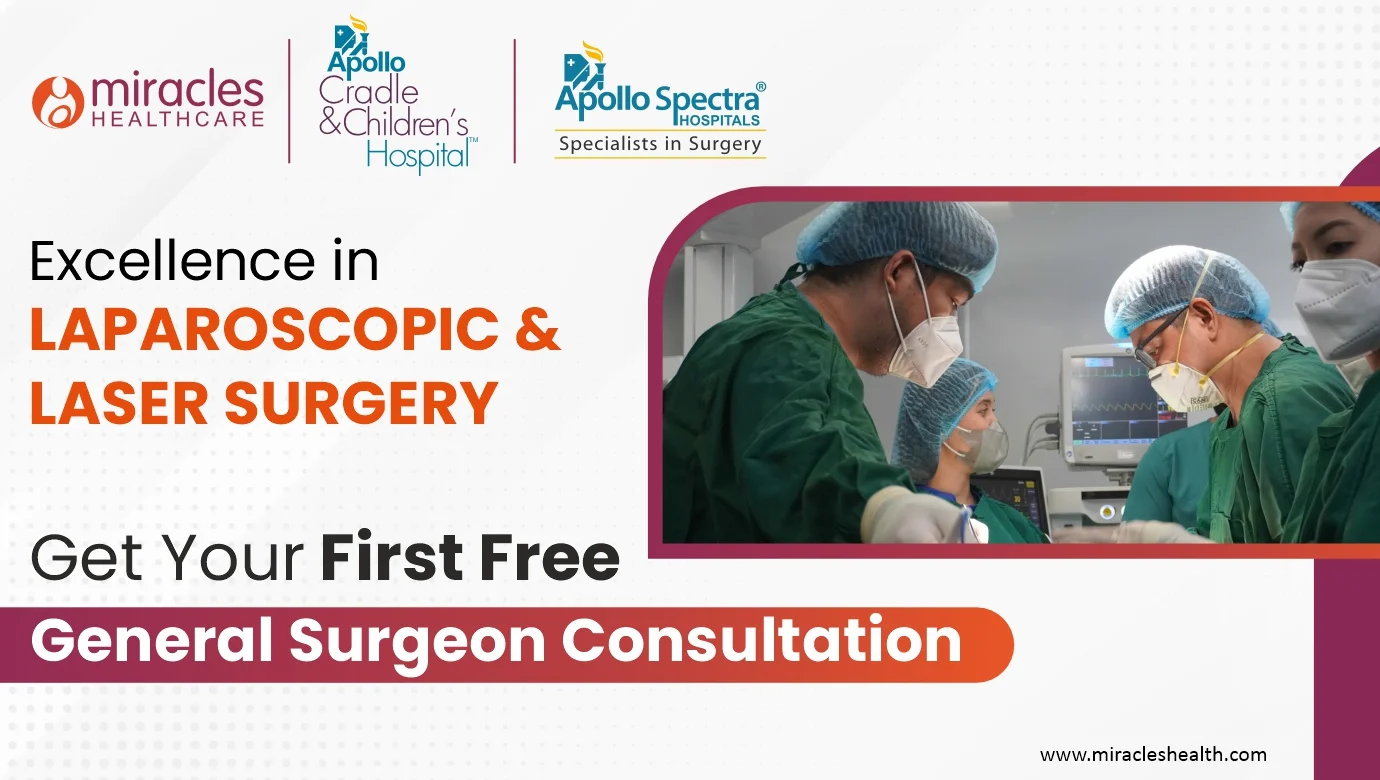General Surgery Conditions We Treat
Comprehensive Care for Your Health

Deep vein thrombosis (DVT) treatment involves anticoagulant medications to prevent the growth of clots and its associated complications, alongside compression therapy to improve blood flow. In severe cases, thrombolytic therapy or surgery may be required. DVT treatment is used to relieve symptoms, prevent recurrence, and reduce the risk of life-threatening complications like pulmonary embolism.
Deep Vein Thrombosis (DVT) is a serious medical condition characterized by the formation of blood clots in the deep veins of the body, generally in the legs. These blood clots can partly or completely obstruct the flow of blood through the affected vein, leading to symptoms such as leg pain, swelling, warmth, and redness. If DVT disease is left untreated, the blood clots can break and travel through the bloodstream, causing life-threatening complications such as pulmonary embolism (PE). So, it requires immediate treatment.
Deep vein thrombosis (DVT) treatment helps prevent the blood clot from being enlarged, reduces the risk of complications and lowers the possibility of recurrence. The particular treatment approach depends on different factors including the severity of the clot, the individual's overall health, and any underlying conditions.
Deep vein thrombosis (DVT disease) treatment is required for several reasons including:
Prevents the growth of existing blood clots.
Reduces the chance of complications like pulmonary embolism
Prevents the new blood clots formation.
Improves the flow of blood in the affected limb.
Relieve the symptoms of DVT disease such as swelling and pain
Promotes blood circulation and healing
Minimizes risk of long-term complications
Prevents recurrence of DVT
If you are experiencing the signs of deep vein thrombosis, it is important to consult the best DVT specialist for diagnosis and the best possible treatment.
Here are the general criteria for the right candidates for DVT disease treatment:
The candidate with a confirmed diagnosis of deep vein thrombosis (DVT) through imaging tests such as ultrasound or venography.
Individuals typically indicate DVT Symptoms such as pain swelling, warmth, and redness in the leg.
Individuals with certain risk factors such as a family history of blood clots, long-term immobility, recent surgery, trauma, obesity, pregnancy, smoking, use of hormonal birth control or hormone replacement therapy, etc. are more likely to develop DVT and may be considered for treatment.
Candidates with complications of DVT, such as pulmonary embolism, or those at risk of developing complications, may require immediate treatment.
The candidate with any pre-existing medical conditions such as cancer, heart disease, or liver disease, will also influence the choice and timing of treatment.
It's important for individuals who suspect they may have DVT or who have been diagnosed with deep vein thrombosis to consult with a general surgery specialist for complete evaluation and treatment tailored to their specific situation.
Preparing for DVT treatment involves several steps to ensure you are both physically and mentally ready for the process. Here is a guide on how to prepare:
Educate yourself about DVT, its causes, symptoms, treatment options, and potential complications. Understanding the condition will help you make informed decisions and actively participate in your treatment plan.
Schedule an appointment with a general surgeon specialized in Deep vein thrombosis (DVT) treatment to discuss your symptoms, medical history, and any concerns you have about the treatment.
Inform the doctor about any medications, supplements, or herbal remedies you are taking. They may suggest you adjust or temporarily stop some medications before certain treatments.
If your treatment plan includes any procedure like surgery or catheter-directed thrombolysis, follow any pre-procedure instructions regarding fasting, hydration, medication management, and avoiding specific activities.
Ensure that you have scheduled follow-up appointments with your doctor to monitor your progress, and adjust treatment as needed.
Follow any lifestyle recommendations such as maintaining a healthy diet, staying physically active within recommended limits, avoiding smoking and excessive alcohol consumption, and wearing compression stockings if recommended.
By taking these steps to prepare in consultation with your surgeon for DVT treatment, you can increase your chances of a successful outcome and a smoother recovery process.
Treatment for deep vein thrombosis depends on several factors, including the size and location of the clot, the patient's overall health, and any underlying conditions. Here are common treatment methods for DVT.
Anticoagulant Medications (Blood Thinners): Anticoagulants are the primary treatment for DVT to prevent new blood clots from forming and stop existing clots from getting larger. Commonly used anticoagulants include Heparin, Warfarin, and Direct Oral Anticoagulants (DOACs) such as apixaban, rivaroxaban, dabigatran, and edoxaban.
Thrombolytic Therapy: This deep vein thrombosis therapy may be used in the case of severe DVT or when there is a possibility of complications. Thrombolytic therapy involves administering clot-dissolving medications directly into the clot via a catheter.
Vena Cava Filter: For patients who develop new blood clots despite treatment, or who can't take anticoagulant medications, a vena cava filter may be inserted into the vena cava (large vein in the abdomen). This filter catches blood clots before they can reach the lungs and causes a pulmonary embolism.
Compression Stockings: These are tight-fitting garments worn on the legs to improve blood flow and reduce swelling. They are generally recommended to prevent post-thrombotic syndrome.
Elevation and Movement: Elevating the affected leg and staying active may help improve blood flow and reduce swelling. However, it's important to avoid prolonged sitting or standing to reduce the risk of blood clot development.
Surgery: In rare cases, DVT surgery may be necessary to repair damaged veins or remove a large clot from the vein. This is usually considered when other DVT treatments are ineffective.
Long-Term Management: Depending on the underlying cause of DVT and the individual's risk factors, long-term management may recommended. It involves ongoing anticoagulant therapy or other preventive measures to reduce the risk of recurrence.
Here are some specific advantages of Deep vein thrombosis (DVT) treatment:
Prevention of Pulmonary Embolism (PE): One of the major advantages of DVT treatment is the prevention of pulmonary embolism. By preventing the blood clot from moving to the lungs and blocking blood flow, treatment reduces the risk of a potentially life-threatening complication.
Prevention of Post-Thrombotic Syndrome (PTS): DVT treatment can help reduce the risk of post-thrombotic syndrome. By preventing further damage to the veins and improving blood flow, treatment can minimize the risk of long-term complications.
Reduced Risk of Recurrence: Proper treatment of DVT can lower the risk of recurrent blood clots in the future. By managing underlying risk factors and using preventive measures individuals can reduce their chance of experiencing another episode of DVT.
Improved DVT Disease Symptoms: Treatment can help relieve DVT symptoms such as swelling, leg pain, and discomfort. By reducing the size of the blood clot and improving the flow of the blood, individuals usually experience relief from these symptoms, leading to a better quality of life.
Prevention of Complications: DVT treatment helps prevent complications related to untreated blood clots, such as chronic venous insufficiency, skin ulcers, and recurrent thrombosis.
Preservation of Vein Function: Treatment helps to preserve the affected veins function and minimize damage to the vascular system.
Enhanced Mobility: By managing symptoms and reducing the risk of complications, DVT disease treatment can help improve mobility and allow individuals to resume their normal routine activities without any limitations.
Here is what to expect after DVT treatment:
Improved Symptoms: With successful treatment, symptoms associated with DVT such as leg pain, swelling, and discomfort start improving gradually. However, some individuals may experience untreated symptoms, specifically if complications like post-thrombotic syndrome occur.
Continued Monitoring: After completing the initial phase of treatment, individuals typically require ongoing monitoring to evaluate the effectiveness of treatment, monitor for complications, and adjust the treatment plan as needed.
Long-Term Medication: Depending on the underlying cause of DVT and individual risk factors, some individuals may need to continue taking anticoagulant medications for an extended period to prevent recurrent blood clots.
Compression Therapy: In cases where individuals develop post-thrombotic syndrome or experience constant leg swelling and discomfort, compression therapy may be recommended.
Follow-Up Care: Regular follow-up care is important to monitor complications, assess treatment effectiveness, and manage any concerns that arise. Individuals need to attend all scheduled follow-up appointments to discuss with their doctor.
After DVT treatment, it is important to take some precautions and follow-up care with your surgeon to promote healing, reduce the risk of complications, and prevent recurrence. Here are some important care measures to consider:
Continue Medications: If you are prescribed anticoagulant medications, continue taking them as directed by your surgeon. Consult your doctor to adjust the dosage to prevent an increase in the risk of blood clots or bleeding complications.
Monitor for Signs or Symptoms of Complications: Be alert for any signs or symptoms of complications such as sudden shortness of breath, chest pain, persistent leg pain, swelling, skin changes, or bleeding complications. Immediately report your concerning symptoms to your surgeon.
Compression Therapy: If your surgeon has recommended for compression therapy, wear compression stockings as directed. These stockings can help improve blood flow in the legs and reduce the risk of swelling and post-thrombotic syndrome.
Adopt a Healthy Lifestyle: Maintaining a healthy lifestyle helps support overall heart health and reduce the risk of recurrent blood clots. Including regular physical activity, eating a well-balanced diet, maintaining a healthy weight, and avoiding tobacco and excessive alcohol in your routine.
Stay Hydrated: Drink plenty of fluids to stay hydrated, as dehydration can increase the chance of blood clots.
Move Regularly: Avoid sitting or standing for prolonged periods. Take a break to move and stretch your legs regularly, especially during long periods of travel or inactivity.
Follow-Up Appointments: Attend all scheduled follow-up appointments with your healthcare provider for ongoing monitoring and assessment. These appointments may involve physical examinations, blood tests, imaging tests (e.g., ultrasound), and discussions about your progress and any changes in your treatment plan.
By following these care measures after DVT treatment, you may reduce the chance of complications, promote healing, and improve your overall well-being.
While treatment for deep vein thrombosis (DVT) is typically effective in preventing complications and reducing the risk of recurrence, however, it can also cause specific risks and complications. Here are some risks and complications associated with DVT treatment:
Bleeding: Anticoagulant medications, which are commonly used to treat DVT, can increase the possibility of bleeding. Patients may experience bleeding from minor cuts or injuries, and severe bleeding events such as gastrointestinal bleeding or intracranial hemorrhage.
Heparin-Induced Thrombocytopenia (HIT): Heparin is the most commonly used anticoagulant medication to treat DVT, and can rarely cause a condition called heparin-induced thrombocytopenia (HIT). This condition is characterized by a sudden decrease in platelet count.
Allergic Reactions: Some individuals may experience allergic reactions to anticoagulant medications, especially heparin. Symptoms of an allergic reaction may include rash, itching, swelling, difficulty breathing, or anaphylaxis and require immediate attention.
Risk of Recurrent Blood Clots: Even with DVT treatment, there is always a risk of recurrent blood clots, especially in patients with underlying risk factors such as genetic predisposition, certain medical conditions, or lifestyle factors.
Post-Thrombotic Syndrome (PTS): This complication occurs after DVT treatment, and is characterized by chronic leg pain, swelling, skin changes, and sometimes ulcers. Despite successful treatment of the blood clot, vein damage and impaired flow of the blood may lead to ongoing symptoms in some individuals.
Pulmonary Embolism (PE): In rare cases, treatment for DVT, especially surgical intervention or thrombolytic therapy can displace blood clots and increase the risk of pulmonary embolism (PE).
Complications of Thrombolytic Therapy: Thrombolytic therapy, which involves administering clot-dissolving medications, carries a risk of bleeding, including intracranial hemorrhage. This treatment therapy is typically used for severe cases of DVT with a high risk of complications.
Surgical Risks: Surgical interventions for DVT, such as thrombectomy or placement of a vena cava filter, carry risks related to anesthesia, infection, bleeding, and damage to surrounding tissues or organs.
It's important for individuals undergoing DVT treatment to be aware of these potential risks and to discuss them with their surgeon.
Factors affecting the cost of DVT treatment include:
Geographic Location and Doctor's Charges
Insurance Coverage
Treatment Method (Medication, Thrombolytic Therapy, Surgery)
Duration of Treatment
Type of Anticoagulant Medication
Diagnostic & Imaging Tests (Blood Tests, Ultrasound, CT and MRI scan, Venography)
Hospitalization Costs
Surgical Procedures (Thrombectomy, Vena Cava Filter Placement)
Follow-Up Care and Monitoring
Complications and Additional Treatments
Miracles Apollo Cradle/Spectra is the best hospital renowned for its comprehensive DVT treatment facilities, boasting a team of highly experienced general surgeons in Gurgaon who specialize in managing conditions like deep vein thrombosis. The hospital offers state-of-the-art diagnostic tools and treatment options, including advanced anticoagulant therapy, thrombolytic therapy, and minimally invasive procedures like thrombectomy. With a focus on patient-centered care and cutting-edge technology, we ensure optimal outcomes for individuals seeking treatment for DVT.
If you are looking for the best treatment for deep vein thrombosis (DVT), Book an online doctor consultation with us.


Comprehensive Care for Your Health
Meet our expert team of General Surgeon where compassionate care meets expertise.
Inspiring Journeys: True Patient Stories
Miracles Apollo Cradle is a leading Maternity Hospital Gurgaon. We strive to give the best care to our patients.






Your Health, Our Network: Comprehensive Care Across Every Facility.
Learn about the world class health care we provide
Expert Advice and Health Tips
Learn about the world class health care we provide
DVT treatment is used to manage and prevent complications of deep vein thrombosis, including pulmonary embolism, post-thrombotic syndrome, and recurrent blood clots.
The time it takes to recover from DVT treatment varies depending on different factors such as the size and location of the clot, the effectiveness of treatment, and individual factors. Symptoms usually improve within a few weeks to months with appropriate treatment, but remaining complications may continue.
DVT treatment is generally safe but carries risks such as bleeding and allergic reactions to medications.
The best treatment for DVT depends on different factors such as the severity of the clot, the individual's overall health, and any underlying conditions. Generally, anticoagulant medications are the primary treatment, along with measures to improve the flow of blood and prevent complications.
The cost of DVT treatment can vary significantly depending on factors such as the treatment technique, duration of treatment, doctor's fees, diagnostic tests, medications, and insurance coverage. To know about the best DVT treatment suitable along with its cost, consult the best general surgeon near you.
DVT treatment is generally safe but carries risks such as bleeding and allergic reactions to medications.